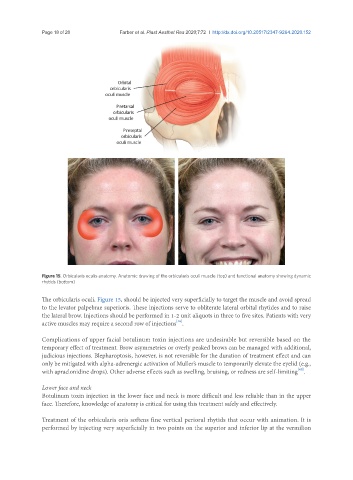Page 868 - Read Online
P. 868
Page 18 of 28 Farber et al. Plast Aesthet Res 2020;7:72 I http://dx.doi.org/10.20517/2347-9264.2020.152
Figure 15. Orbicularis oculis anatomy. Anatomic drawing of the orbicularis oculi muscle (top) and functional anatomy showing dynamic
rhytids (bottom)
The orbicularis oculi, Figure 15, should be injected very superficially to target the muscle and avoid spread
to the levator palpebrae superioris. These injections serve to obliterate lateral orbital rhytides and to raise
the lateral brow. Injections should be performed in 1-2 unit aliquots in three to five sites. Patients with very
[46]
active muscles may require a second row of injections .
Complications of upper facial botulinum toxin injections are undesirable but reversible based on the
temporary effect of treatment. Brow asymmetries or overly peaked brows can be managed with additional,
judicious injections. Blepharoptosis, however, is not reversible for the duration of treatment effect and can
only be mitigated with alpha-adrenergic activation of Muller’s muscle to temporarily elevate the eyelid (e.g.,
[43]
with apraclonidine drops). Other adverse effects such as swelling, bruising, or redness are self-limiting .
Lower face and neck
Botulinum toxin injection in the lower face and neck is more difficult and less reliable than in the upper
face. Therefore, knowledge of anatomy is critical for using this treatment safely and effectively.
Treatment of the orbicularis oris softens fine vertical perioral rhytids that occur with animation. It is
performed by injecting very superficially in two points on the superior and inferior lip at the vermilion

